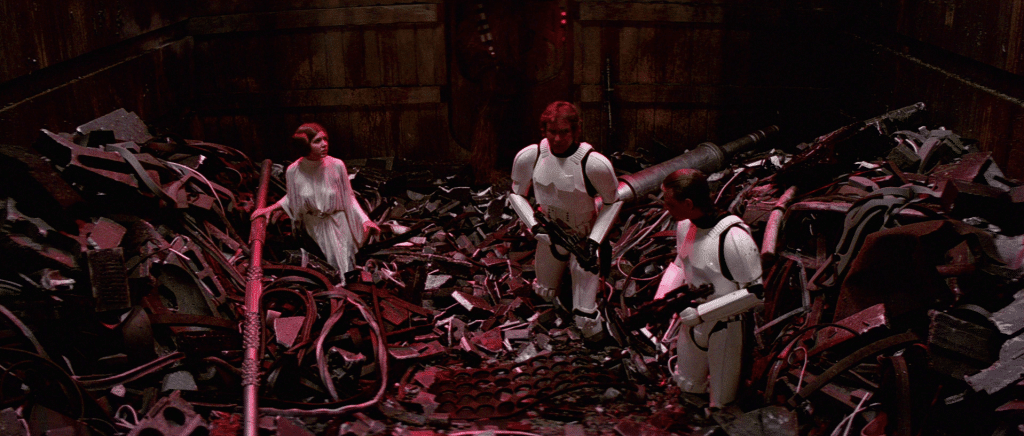The Death Star is as big as a moon and let’s just assume it is roughly as dense as a Naval ship, because that’s a perfectly reasonable assumption but, more importantly, I need you to do that to make my stupid article work.
That type of mass would create a bit of surface gravity. Not much, mind you. But still enough that if you chucked your McDonald’s trash out the side of the Death Star into the vacuum of space, your Mickey-D’s wrappers would fall back and land somewhere else on the death star, even if you gave it a good heave-ho.
Even if you fired the trash out of a t-shirt cannon probably. So if simply shoving something out an airlock would result in it falling back towards the Death Star, then what do you do with your trash? Well, we’ve seen the trash compactor scene in A New Hope, so…SPOILERS, I guess. But let’s play along and see where this goes.
I mentioned previously that we can imagine the Death Star as a Naval ship, so let’s take a detour to lean into that a little more. The Navy is expected to adhere to MARPOL 73/78, which are the International protocols and maritime laws used to prevent pollution by seafaring vessels.
So the short story is that a ship like an aircraft carrier sorts their trash. Organics like banana peels are allowed to by chucked over the side, while other waste like plastics is pulped, shredded, or chunked before being compressed into a big pancake-shaped wagon wheel that is called a trash disk.
Shred, then compact. And those discs are supposed to be stored onboard until they can be later disposed of properly while in harbor. But things don’t always go that way. See below. (NSFW: Language)
And here is a look at the discs, after some had been found washed up on the beaches of the Outer Banks.
I’m one of those planet-loving liberals they mock in the video, so the dumping of trash into the ocean cheeses me off, but that’s not the point I’m trying to make here. Properly disposing of waste has heavy strategic advantages as well.
There are oodles of stories from the Cold War era that told of Soviet ships that would masquerade as simple merchants, masking a full array of sophisticated surveillance gear. These sly Soviet vessels would shadow U.S. Naval ships, hoping to gather military intel.
How did they track the Navy vessels? Well, they followed the trash, of course. Ships dumping their trash overboard created a Hansel and Gretel-like breadcrumb trail that was shockingly easy to follow. Then the solid waste was retrieved and sorted through like a crook looking for a credit card statement in your household trash.

Now let’s bring this back to the Death Star. We’ve already talked about how the sheer size of the Death Star created enough gravity to pull trash back toward it. Well, they could dump waste into the power core and allow proton torpedos to vaporize it. /ahem/
But vaporized stuff doesn’t just “cease to exist.” Even if they would have spewed vaporized trash out a t-shirt cannon nozzle, Death Star engineers still would have had to eject it fast enough to prevent the slower particles from falling back on the Death Star. No Imperial wants a Death Star covered in a thin layer of waste. It’s gross and doesn’t fit the cleanliness profile of the blacks, whites, and grays the Empire was known for.
Besides, the Death Star is big, the size of a moon. You’d need a sophisticated waste management system to move trash through the corridors. Han Solo and Finn understood this, having been an Imperial for a moment.
Trash from the center would need to be moved through miles of station before it could be vented into space, so the more compact it is the better, unless you want your entire station to be taken up by garbage chutes.
Besides, compacting is just hydraulics. Vaporization would use a lot of energy, and also creates the problem of transporting a lot of very hot gas through pipes that run the risk of bursting. That’d be a hot mess. And pulping into some sort of liquid sluice would simply be stinky and you’d have tanks of liquid waste sloshing around in corridors.
So compacting it is. But before compacting, the Empire would want clean up any organics. Seeding each compactor with a scavenging creature makes sense. Besides, trash attracts little vermin like rats or monkey-lizards, so having a creature to eat the vermin kills two birds with one stone.
The compacted trash is then easier to move around than loose piles. Plus, it could then be launched out of the gravity well with far less hassle and mess. It wouldn’t fall apart, so it could even to jettisoned in a strategically helpful direction, away from typical flight lanes.
Just like a Naval ship shouldn’t randomly throw trash overboard, lest they be laying down a trail to be followed, the Imperials chose appropriate times to eject trash. They dump right before a jump. Han took advantage of this.
Think of the Millennium Falcon as a Corellian Freighter version of a big trash disc.
What did we learn here? IDK, it’s just a movie, so don’t start a petition if my research into Imperial Navy Waste Management got a little something wrong. It’s just fun to think how scenes from the movies us nerds love can have interesting little parallels in the Galaxy that’s not far away.

